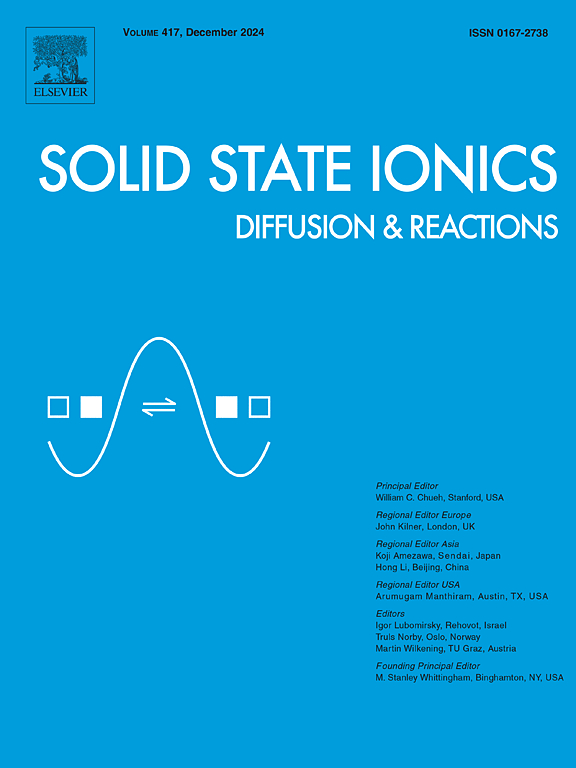Li3BO3 decoration endows fast reaction kinetics of LiFePO4 cathode for lithium ion batteries
IF 3.3
4区 材料科学
Q3 CHEMISTRY, PHYSICAL
引用次数: 0
Abstract
Olivine-type lithium iron phosphate is widely used as a cathode material for lithium-ion batteries because of its moderate operating voltage, excellent stability, and high safety. However, the high rate capability of LiFePO4 is limited by its low electrical conductivity. Additionally, its interface and internal structure would degrade under high-rate conditions. To address these issues, Li3BO3 was prepared via sol-gel method as the surface decoration to enhance the rate performance of LiFePO4. The Li3BO3 decorated LiFePO4 (B-LiFePO4) maintains the structural integrity during cycling under large current densities, furthermore, it induces the formation of favorable cathode-electrolyte interface (CEI) with less Li2CO3 and more Li2O contents, and reduces the activation energy of Li+ diffusion in the CEI layer and charge transfer, thus the high capacity and long cycle performances of LiFePO4 are achieved when cycled at high current densities. At ambient environment and 30C, B-LiFePO4 delivers a high reversible capacity of 63.1 mAh g−1, and a capacity retention of 90 % can be realized over 600 cycles at 1C. In contrast, the original LiFePO4 delivers only 27.8 mAh g−1 at 30C and a capacity retention of 67.2 % after 600 cycles at 1C. Besides, B-LiFePO4 demonstrates good low temperature performance, it exhibits high capacities of 122.1 and 80.7 mAh g−1 at 1C, 0 °C and − 20 °C, respectively. This study provides a simple method to enhance the reaction kinetics of LiFePO4 cathode, which would benefit the development of LiFePO4 based lithium ion batteries with high rate performance.
Li3BO3修饰赋予了LiFePO4锂离子电池正极快速反应动力学
橄榄石型磷酸铁锂因其工作电压适中、稳定性好、安全性高而被广泛用作锂离子电池的正极材料。然而,LiFePO4的高倍率性能受到其低导电性的限制。此外,它的界面和内部结构在高速率条件下会退化。为了解决这些问题,采用溶胶-凝胶法制备Li3BO3作为LiFePO4的表面装饰,以提高LiFePO4的速率性能。经过Li3BO3修饰的LiFePO4 (B-LiFePO4)在大电流密度循环过程中保持了结构的完整性,形成了Li2CO3含量少、Li2O含量高的阴极-电解质界面(CEI),降低了CEI层中Li+扩散和电荷转移的活化能,从而实现了LiFePO4在大电流密度循环时的高容量和长周期性能。在室温和30C下,B-LiFePO4可提供63.1 mAh g−1的高可逆容量,并且在1C下可实现超过600次循环的90%的容量保持。相比之下,原始的LiFePO4在30C下仅提供27.8 mAh g - 1,在1C下循环600次后容量保持率为67.2%。此外,B-LiFePO4具有良好的低温性能,在1C、0°C和- 20°C时,其容量分别为122.1和80.7 mAh g - 1。本研究为提高LiFePO4正极的反应动力学提供了一种简单的方法,这将有利于LiFePO4基锂离子电池的高倍率性能的发展。
本文章由计算机程序翻译,如有差异,请以英文原文为准。
求助全文
约1分钟内获得全文
求助全文
来源期刊

Solid State Ionics
物理-物理:凝聚态物理
CiteScore
6.10
自引率
3.10%
发文量
152
审稿时长
58 days
期刊介绍:
This interdisciplinary journal is devoted to the physics, chemistry and materials science of diffusion, mass transport, and reactivity of solids. The major part of each issue is devoted to articles on:
(i) physics and chemistry of defects in solids;
(ii) reactions in and on solids, e.g. intercalation, corrosion, oxidation, sintering;
(iii) ion transport measurements, mechanisms and theory;
(iv) solid state electrochemistry;
(v) ionically-electronically mixed conducting solids.
Related technological applications are also included, provided their characteristics are interpreted in terms of the basic solid state properties.
Review papers and relevant symposium proceedings are welcome.
 求助内容:
求助内容: 应助结果提醒方式:
应助结果提醒方式:


